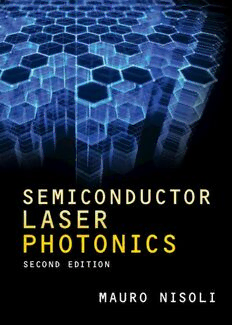Table Of ContentSemiconductorLaserPhotonics
Thismoderntextprovidesdetailedcoverageoftheimportantphysicalprocessesunderpin-
ningsemiconductordevices.Advancedanalysisoftheopticalpropertiesofsemiconductors
without the requirement of complex mathematical formalism allows clear physical inter-
pretation of all obtained results. The book describes fundamental aspects of solid-state
physics and the quantum mechanics of electron–photon interactions, in addition to dis-
cussing in detail the photonic properties of bulk and quantum well semiconductors. The
finalsixchaptersfocusonthephysicalpropertiesofseveralwidelyusedphotonicdevices,
includingdistributedfeedbacklasers,verticalcavitysurface-emittinglasers,quantumdot
lasers,andquantumcascadelasers.Thisbookisidealforgraduatestudentsinphysicsand
electricalengineering,andausefulreferenceforopticalscientists.
MauroNisoliisProfessorofPhysicsandPhotonicsatPolitecnicodiMilano,whereheleads
theAttosecondResearchCenter.Hisresearchisfocusedonattosecondscienceandultra-
fastphenomenainmatter.Hehaspublishedmorethan200researchpapersininternational
journalsandseveralphysicstextbooks.
Published online by Cambridge University Press
Published online by Cambridge University Press
Semiconductor Laser
Photonics
SecondEdition
MAURONISOLI
PolitecnicodiMilano
Published online by Cambridge University Press
ShaftesburyRoad,CambridgeCB28EA,UnitedKingdom
OneLibertyPlaza,20thFloor,NewYork,NY10006,USA
477WilliamstownRoad,PortMelbourne,VIC3207,Australia
314–321,3rdFloor,Plot3,SplendorForum,JasolaDistrictCentre,NewDelhi–110025,India
103PenangRoad,#05–06/07,VisioncrestCommercial,Singapore238467
CambridgeUniversityPressispartofCambridgeUniversityPress&Assessment,adepartmentofthe
UniversityofCambridge.
WesharetheUniversity’smissiontocontributetosocietythroughthepursuitof
education,learningandresearchatthehighestinternationallevelsofexcellence.
www.cambridge.org
Informationonthistitle:www.cambridge.org/9781009098748
DOI:10.1017/9781009106153
©MauroNisoli2023
Thispublicationisincopyright.Subjecttostatutoryexceptionandtotheprovisions
ofrelevantcollectivelicensingagreements,noreproductionofanypartmaytake
placewithoutthewrittenpermissionofCambridgeUniversityPress&Assessment.
Firstpublished2023
AcataloguerecordforthispublicationisavailablefromtheBritishLibrary.
ACataloging-in-PublicationdatarecordforthisbookisavailablefromtheLibraryofCongress
ISBN978-1-009-09874-8Hardback
CambridgeUniversityPress&Assessmenthasnoresponsibilityforthepersistence
oraccuracyofURLsforexternalorthird-partyinternetwebsitesreferredtointhis
publicationanddoesnotguaranteethatanycontentonsuchwebsitesis,orwill
remain,accurateorappropriate.
Published online by Cambridge University Press
ToMargherita,
Matilde,andKim
Published online by Cambridge University Press
Published online by Cambridge University Press
Contents
Preface pagexi
1 BandStructureofSemiconductors 1
1.1 Crystals,Lattices,andCells 1
1.2 TheReciprocalLattice 7
1.3 ElectronsinaPeriodicCrystal 10
1.4 TheConceptofEffectiveMass 15
1.5 EnergyBands 16
1.6 CalculationoftheBandStructure 18
1.7 Thek·pMethod 29
1.8 BandstructuresofaFewSemiconductors 32
1.9 Exercises 35
2 ElectronsinSemiconductors 40
2.1 Introduction 40
2.2 PeriodicBoundaryConditions 40
2.3 DensityofStates 42
2.4 CarrierStatisticsinSemiconductors 45
2.5 Mass-ActionLaw 49
2.6 DopedSemiconductors 50
2.7 Quasi-FermiLevelsinNonequilibriumSystems 57
2.8 ChargeTransportinSemiconductors 59
2.9 DiffusionCurrent 63
2.10 Exercises 65
3 BasicConceptsofQuantumMechanics 69
3.1 QuantumMechanicsFundamentals 69
3.2 Time-DependentPerturbationTheory 74
3.3 PropertiesofOperators:AShortSummary 78
3.4 TheDensityMatrix 79
3.5 Exercises 94
vii
Published online by Cambridge University Press
viii Contents
(cid:2)
4 Electron–PhotonInteraction 98
4.1 Introduction 98
4.2 ClassicalElectromagneticTheory 98
4.3 ElectronsinanElectromagneticField 101
4.4 ElectricDipoleApproximation 104
4.5 LinearOpticalSusceptibility 105
4.6 FromOpticalSusceptibilitytoAbsorptionCoefficient 109
4.7 MomentumofanElectroninaPeriodicCrystal 111
4.8 Exercises 114
5 OpticalPropertiesofSemiconductors 116
5.1 StimulatedTransitions:SelectionRules 116
5.2 JointDensityofStates 117
5.3 SusceptibilityandAbsorptionCoefficientinaSemiconductor 119
5.4 GainCoefficientandBernard–DuraffourgCondition 124
5.5 SpontaneousEmission 125
5.6 NonradiativeRecombination 132
5.7 CompetitionbetweenRadiativeandNonradiativeRecombination 144
5.8 Exercises 145
6 QuantumWells 148
6.1 Introduction 148
6.2 ElectronicStates 149
6.3 DensityofStates 155
6.4 ElectronDensity 156
6.5 TransitionSelectionRules 157
6.6 AbsorptionandGaininaQuantumWell 160
6.7 IntersubbandAbsorption 164
6.8 StrainedQuantumWells 166
6.9 TransparencyDensityandDifferentialGain 173
6.10 Excitons 176
6.11 Exercises 185
7 LightEmittingDiodes 188
7.1 BasicConcepts 188
7.2 Double-HeterostructureLEDs 191
7.3 CarrierLeakageoverBarrier 196
7.4 ExternalEfficiencyofaLED 198
7.5 EmissionPatternofaLED 201
7.6 LuminousEfficiency 202
7.7 BlueLED 204
7.8 Exercises 207
Published online by Cambridge University Press
ix Contents
(cid:2)
8 SemiconductorLasers 211
8.1 Introduction 211
8.2 RateEquationsandThresholdConditionsforLaserAction 212
8.3 TemperatureDependence 220
8.4 OutputPower 220
8.5 QuantumWellLasers 222
8.6 LaserStructures 225
8.7 SpectralandSpatialCharacteristicsofDiodeLaserEmission 227
8.8 Exercises 228
9 QuantumDotLasers 232
9.1 Introduction 232
9.2 FabricationTechniquesofQDs 233
9.3 GeneralSchemeofQDLasers 235
9.4 ElectronicStatesinQDs 236
9.5 CarrierStatisticsinQDs 244
9.6 OpticalTransitions 246
9.7 AbsorptionSpectrum 247
9.8 GaininQDs 250
9.9 ThresholdCurrentDensity 251
9.10 AdditionalAdvantagesofQDLasers 255
9.11 Exercises 257
10 DistributedFeedbackLasers 258
10.1 BasicConcepts 258
10.2 Coupled-ModeTheory 262
10.3 DFBLaserwithUniformGrating 266
10.4 DFBLaserwithλ/4-ShiftedGrating 270
10.5 DistributedBraggReflector(DBR)Laser 271
10.6 MATLABProgram:CharacteristicsofaDFBLaser 273
10.7 Exercises 278
11 VerticalCavitySurface-EmittingLasers 281
11.1 BasicStructure 281
11.2 ThresholdConditions 281
11.3 DBRforVCSELs 284
11.4 ThresholdConditionsandCurrentConfinement 287
11.5 AdvantagesandApplications 289
11.6 Exercises 289
Published online by Cambridge University Press

